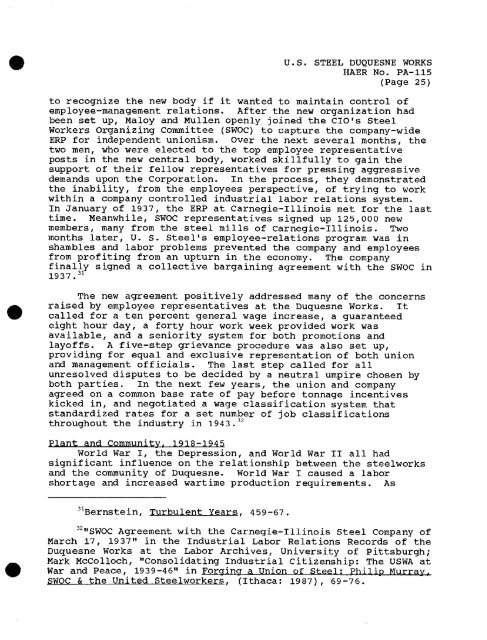pa1778data.pdf
pa1778data.pdf
pa1778data.pdf
You also want an ePaper? Increase the reach of your titles
YUMPU automatically turns print PDFs into web optimized ePapers that Google loves.
U.S. STEEL DUQUESNE WORKS<br />
HAER No. PA-115<br />
(Page 25)<br />
to recognize the new body if it wanted to maintain control of<br />
employee-management relations. After the new organization had<br />
been set up, Maloy and Mullen openly joined the CIO's Steel<br />
Workers Organizing Committee (SWOC) to capture the company-wide<br />
ERP for independent unionism. Over the next several months, the<br />
two men, who were elected to the top employee representative<br />
posts in the new central body, worked skillfully to gain the<br />
support of their fellow representatives for pressing aggressive<br />
demands upon the Corporation, In the process, they demonstrated<br />
the inability, from the employees perspective, of trying to work<br />
within a company controlled industrial labor relations system.<br />
In January of 1937, the ERP at Carnegie-Illinois met for the last<br />
time. Meanwhile, SWOC representatives signed up 125,000 new<br />
members, many from the steel mills of Carnegie-Illinois. Two<br />
months later, U. S. Steel's employee-relations program was in<br />
shambles and labor problems prevented the company and employees<br />
from profiting from an upturn in the economy. The company<br />
finally signed a collective bargaining agreement with the SWOC in<br />
1937. 31<br />
The new agreement positively addressed many of the concerns<br />
raised by employee representatives at the Duquesne Works. It<br />
called for a ten percent general wage increase, a guaranteed<br />
eight hour day, a forty hour work week provided work was<br />
available, and a seniority system for both promotions and<br />
layoffs. A five-step grievance procedure was also set up,<br />
providing for equal and exclusive representation of both union<br />
and management officials. The last step called for all<br />
unresolved disputes to be decided by a neutral umpire chosen by<br />
both parties. In the next few years, the union and company<br />
agreed on a common base rate of pay before tonnage incentives<br />
kicked in, and negotiated a wage classification system that<br />
standardized rates for a set number of job classifications<br />
throughout the industry in 1943. 32<br />
Plant and Community, 1918-1945<br />
World War I, the Depression, and World War II all had<br />
significant influence on the relationship between the steelworks<br />
and the community of Duquesne. World War I caused a labor<br />
shortage and increased wartime production requirements. As<br />
31 Bernstein, Turbulent Years, 459-67.<br />
32 "SWOC Agreement with the Carnegie-Illinois Steel Company of<br />
March 17, 1937" in the Industrial Labor Relations Records of the<br />
Duquesne Works at the Labor Archives, University of Pittsburgh;<br />
Mark McColloch, "Consolidating Industrial Citizenship: The USWA at<br />
War and Peace, 1939-46" in Forging a Union of Steel: Philip Murray,<br />
SWOC & the United Steelworkersr (Ithaca: 1987), 69-76.

















